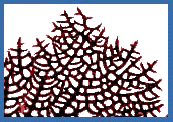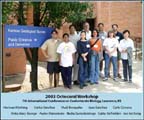
OCTOCORAL
WORKSHOP 2003 Minutes
7th
International Conference on Coelenterate Biology, University of Kansas
Lawrence, Kansas, USA
July
7-13, 2003
| Participants:
Juan A. Sánchez (USA/Colombia); Carlos A. Sánchez-Ortiz
(Mexico); Catherine S. McFadden (USA); Jun-Im Song (Korea); Asako Matsumoto
(Japan); Carlo Cerrano (Italy); Anita Mary (India); Herman Wirshing (USA);
Yehuda Benayahu (Israel); Nadiezhda Santodomingo (Colombia). |
 |
1) Octocorallia classification:
towards a phylogenetic understanding (July 12, 2003, 9-12 PM).
Chair: Juan A. Sánchez
Secretary:
Carlos A. Sánchez-Ortiz
J.A. Sánchez introduced
a number of new phylogenetic findings based on both mitochondrial and nuclear
DNA sequences that are in disagreement with the current taxonomic classification.
The problem and the need for a revised classification of Octocorallia was discussed
and recognized by the attendees. C. S. McFadden then presented phylogenetic
results from a larger sampling of Octocorallia species using mitochondrial DNA
(ND2 and MSH1 genes). These new findings support clades that have been recognized
previously based on 18S and 16S ribosomal DNA sequences and suggest some new
directions for classification of higher taxa. C. A. Sánchez-Ortiz then
presented results of a study using different mitochondrial genes (ATPase6 and
8) that yielded similar results, corroborating the results obtained using other
mitochondrial genes. A number of taxa that could be added to these studies were
identified and targeted for sequencing in the near future. Collaborations among
attendees were offered to collect new and fresh material for further molecular
screening in search of a complete family-level Octocorallia phylogeny using
mitochondrial DNA sequences.
The phylogenetic resolution
of the currently available molecular markers was discussed briefly. Mitochondrial
genes appear to be useful for resolving genus- and family-level relationships
of Octocorallia, but cannot resolve deeper (subordinal or ordinal) or shallower
(intrageneric) relationships. C. A. Sánchez-Ortiz presented results suggesting
that ribosomal ITS sequences may be useful for resolving the relationships of
species within some genera.
The end of the discussion,
called by Y. Benayahu, was on the fact that the study of octocoral diversity
can be enhanced by collaborative efforts between taxonomists and molecular systematists.
This kind of collaboration was thought to be of great strength for securing
funds in the future for systematic studies of Octocorallia. It was clear that
we have to gather and publish information on the type specimens as part of any
new systematic revisions, and also acquire DNA information from both new and
old specimens. The idea of DNA "barcoding" for octocoral species could
be a way to link both taxonomic and molecular work in the near future. We agreed
to focus on ideas that could be presented as real proposals, and we found the
Worldwide Octocoral Biodiversity (WOB) Project presented by C. Sánchez-Ortiz
to be a good way to organize them.
2) Worldwide Octocoral
Biodiversity (WOB) Project (July 12, 2003, 2-5 PM).
Chair: Carlos A. Sánchez-Ortiz
Secretary:
Carlos Perez (Workshop organizer, could not attend), Juan A. Sánchez.
(alternate).
C. A. Sánchez-Ortiz
presented an idea that he summarized in a handout about the WOB. Originally
the project focused on the compilation of a complete list of all octocoral species
plus taxonomic information. The idea was discussed by the group and modified
to include the addition of new surveys (both field and molecular) and training.
Finally, we modified the original idea of a species list database into a more
elaborate web-based bank of information similar to that being developed for
Hexacorallia. We discussed and proposed 11 fields that every species record
should ideally have:
1. Species name (link to
higher classification & Tree of Life, TREEBASE, Phylogeny, etc)
2. Synonymy, authority,
and references
3. Type specimens (provenance,
photos) & material information (sclerites, histology)
4. Geographical distribution
(link to GIS map of ranges)
5. Habitat features (depth,
substrate)
6. Description (diagnostic
characters)
7. Photographs (both living
and preserved)
8. Variability and comparisons
(link to taxon identification keys)
9. Sequences (Genbank accession
numbers) (link to DNA BarCode if available)
10. Natural products chemistry
11. Natural history (reproduction
& development, physiology, symbionts)
Detailed information on
WOB is presented in an attached document.
- Conclusions and Future
plans (July 13, 2003).
We started the day with
a presentation by Marymegan Daly (U. Kansas) about the NSF "Assembling the Tree
of Life" (AToL) grant proposal that is currently being organized by researchers
at the University of Kansas (and other US institutions). The AToL initiative
funds large multi-institutional projects "to … resolve phylogenetic relationships
for large groups of organisms" (e.g. phyla). The U. Kansas proposal will focus
on constructing a family-level molecular phylogeny of all cnidarians, and consequently
they want and need the participation of octocoral researchers. Researchers from
any country can be supported as collaborators or contractors on this grant.
The proposal is due in May 2004; an initial draft will be discussed at the SICB
meetings in New Orleans in January, and a nearly final draft will be circulated
in March. We will stay in contact with the principal investigators (Meg Daly
& Paulyn Cartwright) as the proposal is developed.
Dauphne
Fautin, conference organizer, together with all the participants of the bioinformatics
workshop (held in parallel), joined us to discuss the database ideas for Octocorallia.
After discussing the database briefly, we all decided that the Hexacoral database
being developed and managed by her group at the U. of Kansas (http://www.kgs.ukans.edu/Hexacoral/)
would be the best place to deposit an Octocorallia database, as only minor modifications
would be necessary to include the information fields we desire. The Hexacoral
database is also now being expanded to include the Hydrozoa and Scyphozoa. We
suggested the possibility of adding electronic documentation (e.g., PDF files)
to such a database and were told it was a reasonable goal and included in on-going
plans for the database.
Overall, the value of collaborations
was the main point we all agreed on. As for fund raising possibilities, we discussed,
in addition to the AToL grant proposal, the possibility of applying for diverse
opportunities in the U.S. (e.g., NSF taxonomic and biodiversity initiatives
such as PEET grants), Mexico (CONABIO), and some others in Europe. Collaboration
with researchers studying other organisms to explore whole faunas (e.g, invertebrate
and vertebrate) could also be considered. An example of this kind of collaboration
was presented by N. Santodomingo in the case of Colombia (Invemar). The easiest
way to collaborate seemed to be to focus on specific, small projects but to
follow some of the ideas already presented in order to contribute to the big
picture (e.g., WOB). We also want to extend this collaboration to all Octocoral
systematists currently active worldwide. We will be trying to organize another
workshop during 2004-2006 following another meeting of international relevance
(e.g, Coral Reef Symposium or 8th ICCB).
- Addresses of attendees
(in alphabetical order).
|
Name
|
Address
|
e-mail
|
|
Yehuda Benayahu
|
Department of Zoology
Tel Aviv University
Ramat Aviv 69978
Tel Aviv, Israel
|
yehudab@tauex.tau.ac.il
|
|
Carlo Cerrano
|
University of Genoa,
Italy
|
cerrano@dipteris.unige.it
|
|
Anita Mary George
|
Institute
for Environmental Research and Social Education (IERSE)
14/C3,
Nesamony Nager, Nagercoil-629001
Kanyakumari
District, Tamil Nadu State, INDIA |
sponge23in@yahoo.co.in
aniji5@rediffmail.com
|
|
Asako K. Matsumoto
|
Marine Ecosystems
Research Department
Japan Marine
Science and Technology Center
2-15, Natsushima-cho,
Yokosuka,
237-0061 JAPAN
|
amatsu@jamstec.go.jp
amatsu@sakura.email.ne.jp
|
|
Catherine S. McFadden
|
Department of Biology
Harvey Mudd
College
1250 N. Dartmouth
Ave.
Claremont,
CA 91711 USA
|
mcfadden@hmc.edu
|
|
Carlos Perez (absent)
|
Departamento de Zoologia
- CCB
Universidade Federal de Pernambuco
Rua Moraes Rego 1235, Cidade Universitaria, CEP: 50670-420
Recife-PE, Brasil
|
cdperez@ufpe.br
|
|
Juan Armando Sánchez
|
Laboratories of Analytical
Biology
Museum Support
Center, MRC 534
4210 Silver
Hill Rd.
Smithsonian
Institution
Suitland,
MD 20746, USA
|
jsanchez@lab.si.edu
http://www.acsu.buffalo.edu/~js15
|
|
Carlos A. Sanchez-Ortiz
|
Australian Institute
of Marine Science
Townsville, Australia., or,
Universidad Autónoma
de Baja California Sur, La Paz, B.C.S. km 5.5 carretera la sur, AP 23080,
Mexico
|
c.sanchez@aims.gov.au
csanchez@uabcs.mx
|
|
Nadia Santodomingo
|
Marine and Coastal
Research Institute. INVEMAR. Colombia. AA 1016. +57-54214775 Ext. 144
|
nadiaks@invemar.org.co
|
|
Jun-Im Song
|
Department of Life
Sciences
Ewha Womans
University
Seoul 120-750, Korea
|
jisong@mm.ewha.ac.kr
|
|
Herman H. Wirshing
|
Nova International
University
8445 SW 54 St.
Miami,
FL 33143
|
wirshing@nova.edu,
plexaura@lycos.com
|


